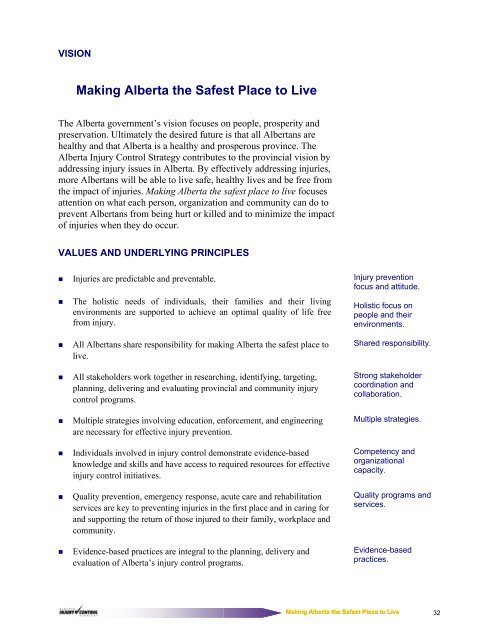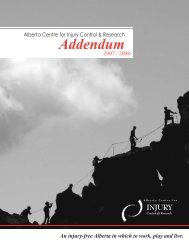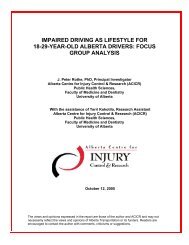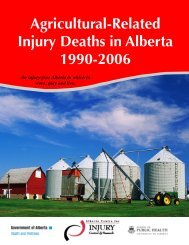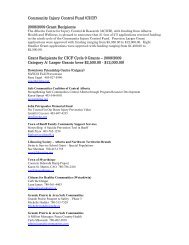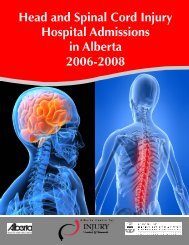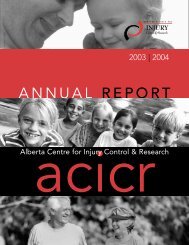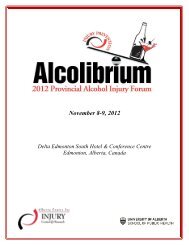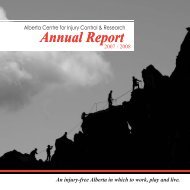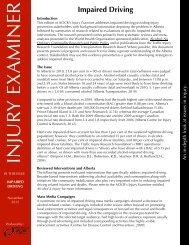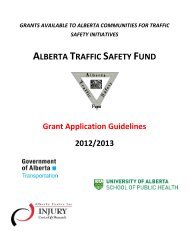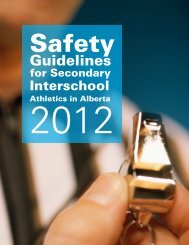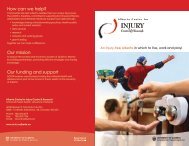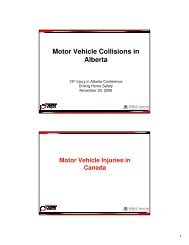JUNE 2003 - Alberta Centre for Injury Control & Research
JUNE 2003 - Alberta Centre for Injury Control & Research
JUNE 2003 - Alberta Centre for Injury Control & Research
Create successful ePaper yourself
Turn your PDF publications into a flip-book with our unique Google optimized e-Paper software.
VISION<br />
Making <strong>Alberta</strong> the Safest Place to Live<br />
The <strong>Alberta</strong> government’s vision focuses on people, prosperity and<br />
preservation. Ultimately the desired future is that all <strong>Alberta</strong>ns are<br />
healthy and that <strong>Alberta</strong> is a healthy and prosperous province. The<br />
<strong>Alberta</strong> <strong>Injury</strong> <strong>Control</strong> Strategy contributes to the provincial vision by<br />
addressing injury issues in <strong>Alberta</strong>. By effectively addressing injuries,<br />
more <strong>Alberta</strong>ns will be able to live safe, healthy lives and be free from<br />
the impact of injuries. Making <strong>Alberta</strong> the safest place to live focuses<br />
attention on what each person, organization and community can do to<br />
prevent <strong>Alberta</strong>ns from being hurt or killed and to minimize the impact<br />
of injuries when they do occur.<br />
VALUES AND UNDERLYING PRINCIPLES<br />
• Injuries are predictable and preventable. <strong>Injury</strong> prevention<br />
focus and attitude.<br />
• The holistic needs of individuals, their families and their living<br />
environments are supported to achieve an optimal quality of life free<br />
from injury.<br />
Holistic focus on<br />
people and their<br />
environments.<br />
• All <strong>Alberta</strong>ns share responsibility <strong>for</strong> making <strong>Alberta</strong> the safest place to<br />
live.<br />
• All stakeholders work together in researching, identifying, targeting,<br />
planning, delivering and evaluating provincial and community injury<br />
control programs.<br />
• Multiple strategies involving education, en<strong>for</strong>cement, and engineering<br />
are necessary <strong>for</strong> effective injury prevention.<br />
• Individuals involved in injury control demonstrate evidence-based<br />
knowledge and skills and have access to required resources <strong>for</strong> effective<br />
injury control initiatives.<br />
• Quality prevention, emergency response, acute care and rehabilitation<br />
services are key to preventing injuries in the first place and in caring <strong>for</strong><br />
and supporting the return of those injured to their family, workplace and<br />
community.<br />
• Evidence-based practices are integral to the planning, delivery and<br />
evaluation of <strong>Alberta</strong>’s injury control programs.<br />
Shared responsibility.<br />
Strong stakeholder<br />
coordination and<br />
collaboration.<br />
Multiple strategies.<br />
Competency and<br />
organizational<br />
capacity.<br />
Quality programs and<br />
services.<br />
Evidence-based<br />
practices.<br />
Making <strong>Alberta</strong> the Safest Place to Live<br />
32


